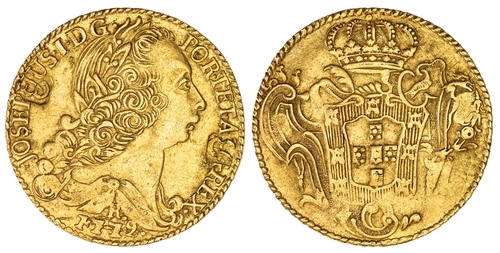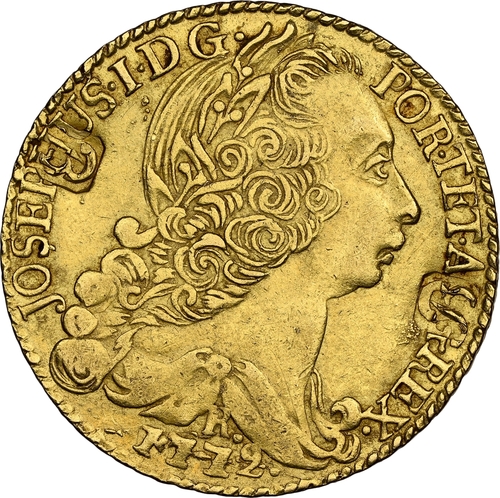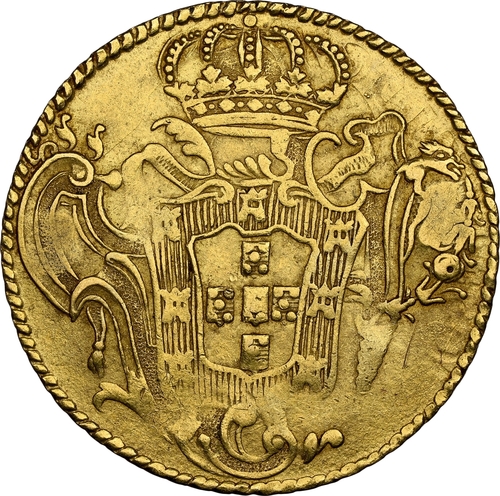Auction: 25055 - British Medals and World Coins featuring The Hurter-Amman Collection of Ancient and European Gold
Lot: 831
British Virgin Islands (1798 - c. 1803), "West Indies Script B" Gold Sixty-Six Shillings, struck over a Counterfeit 'Half-Joe', in the style of José I, Peca of 6,400 Reis, 1772 R, laureate and draped bust right, script B countermark at 3 and 9 o'clock, rev. crowned and garnished shield, engrailed edge, 11.63g, 12h (cf. Gordon 303, 307 [Countermark]; cf. Roehrs 408; Pridmore, West Indies, 1, 2 and 6 [Unattributed]; cf. John J. Ford [October 1989], lot 272), the host coin softly struck with some rusting to the obverse die, some casual graffiti before face, otherwise a bolder very fine, the countermarks softly struck, about very fine thus, but presumed UNIQUE in this unplugged/further counterstruck state
Before the turn of 1800, the Leeward Islands as well as all British West Indian Islands had established a standard rate for their standard coin, the Half Joe, at 66 Shillings, its weight was fixed at 7 dwt in the four original Leeward Islands and at 8 dwt in the Virgin Islands.
The attribution to the British Virgin Islands stems therefore from the culmination of the reported weight standards, local goldsmith hallmarks, and later added countermarks. Robert Chalmers, author of "History of Currency in the British Colonies" published London 1858, states that before the close of the 18th Century the rating of the Dollar in the Leeward Islands had increased from 8 Bits originally to 10 Bits then 11 Bits of 9 Pence each (8 Shillings 3 Pence and then later to 12 Bits, the only exception to this was the Virgin Islands which remained at the 8s 3d standard (8 dwt). By 1798. the Leeward Islands, which consisted of Antigua and Barbuda, Guadeloupe, Montserrat, St. Kitts and Nevis, St. Martin, Dominica and the Virgin Islands, were plagued with light weight Joes and small quantities of worn silver.
Early in 1798, Martinique, part of the Windward Islands, passed a local Act that raised the Dollar from 8s 3d to 9 shillings to be on par with Grenada and Antigua. This was a restrictive measure to limit the outflow of good silver from the island. Later that year, Dominica imitated the ordnance, with the additional measure of raising the internal rate of gold. Within months, the Leeward Islands had a uniform rating against the Dollar at 9 Shillings, with the only exception being the Virgin Islands which remained at the 8s 3d standard.
Ralph Gordon, author of "West Indies Countermarked Gold Coins" (1987), states that the Windward Islands were on 7 ½ dwt standard and that the Leeward Islands, except for Tortola, used the 7 dwt standard. Tortola and the Danish West Indies used 8 dwt as their standard.
Despite the paucity of surviving examples of 'Script B' countermarks, the preponderence of other local marks on these coins helps to establish a vague sequencing for the punch. For instance the Gordon 303 specimen (ANS 1927.143.1) also bears an "I.H" hallmark which is shared by Gordon 301, that appears alongside a 'Martinique 20 over Eagle' of 1805. The weights of these two examples are just above the 7 dwt standard of the Leeward Islands. Meanwhile Gordon 302 also possesses an incuse "G" stamped thrice near the edges of the obverse specific to the Grenada Proclamation of 31 July 1798. It is also interesting to point out that each of the "G" punches are stamped over "S" in relief within square indent for St. Vincent (Act of 1 August 1798). Gordon states that the West Indies Script B stamp had yet to be recorded as a "single mark" or plugged coin. The fact that this piece has remained at the fixed 8 dwt standard, twinned with the later action of 22 April 1803 by Guadeloupe calling for the removal of debased plugs (Gordon 303) lends credence to the notion that West Indies Script B was active was the 1798 to 1803.
Subject to 20% VAT on Buyer’s Premium. For more information please view Terms and Conditions for Buyers.
Sold for
£2,000
Starting price
£2000









